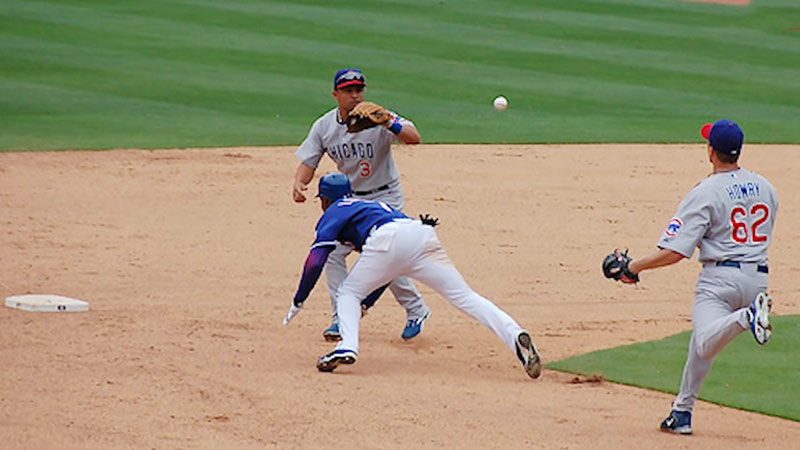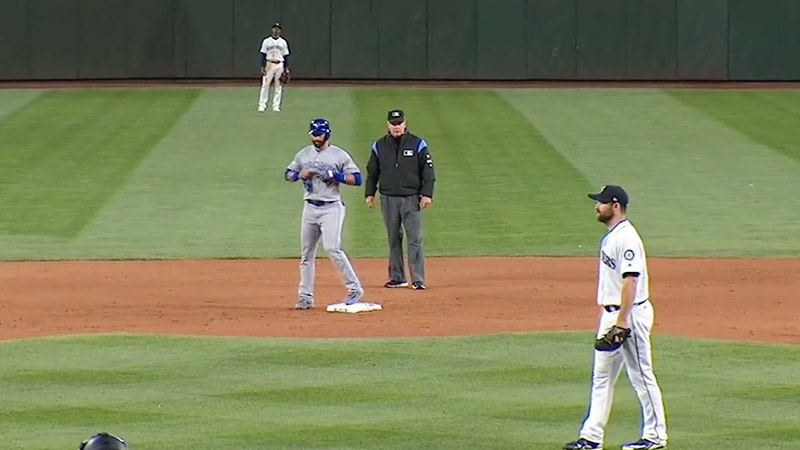Baseball’s allure lies in its nuanced strategies, and the question of stealing second base after a walk adds a layer of complexity to the game.
While a walk traditionally means securing first base, the possibility of immediate advancement to second sparks curiosity.
This blog navigates through the intricacies and rules governing this unconventional play.
We’ll explore the rarity, the potential scenarios where this might occur, and the challenges involved.
From the technicalities of the sport to the psychological gamesmanship on the field, understanding this maneuver unveils a lesser-known aspect of the game, highlighting the delicate balance between strategy, rules, and on-field execution. So, stay sharp.
Can You Steal Second Base After a Walk
There are some aspects that determine whether can you steal a second on a walk. In baseball, advancing to second base after a walk isn’t allowed.
When a batter receives a walk, they’re only entitled to advance to first base. The rules specify that a walk permits the batter to safely reach first base without the opportunity to advance further on that play.
To reach second base, the player must either hit the ball and successfully reach it before being tagged out or attempt a steal while the ball is in play.
While a walk offers a strategic advantage by getting a player on base without needing a hit, it doesn’t grant automatic access to second base, it’s all about making strategic moves to advance further in the game.
The Basics of Stealing 2nd on a Walk
Stealing second base immediately after a walk in baseball presents a unique scenario that challenges the standard rules of the game.
Traditionally, a walk entitles the batter to reach first base without the opportunity for further advancement.
However, rare circumstances or momentary lapses in the defense may create opportunities for a daring base runner to attempt a swift steal to second base.
The feasibility of this maneuver often hinges on the element of surprise, such as the catcher’s delay in returning the ball to the pitcher or a momentary distraction among the defensive players.
When it comes to stealing second base after a walk, it’s an uncommon scenario due to the rules of baseball. Here are a few rare points on this topic:
Technical Loopholes
In very rare instances, if a player attempts to steal while the pitcher is still on the rubber and the umpire hasn’t signaled the next play, there might be an opportunity.
However, this is highly unusual and contingent on the specific timing of the play.
Defensive Oversight
At times, defensive lapses or confusion about the play can create an opening for a runner to exploit and attempt a swift steal to second base.
However, this relies heavily on the defensive team’s errors or lack of attention.
Umpire Discretion
Umpires have some discretion in interpreting and enforcing rules.
In unique situations where there’s ambiguity or an unusual circumstance, an umpire’s judgment might influence whether an attempt to steal second after a walk is permissible.
Historical Anecdotes
Throughout baseball’s long history, there might be instances of unconventional plays or disputed calls involving attempts to steal after a walk.
These episodes often become intriguing footnotes in the sport’s lore due to their rarity.
Little League Stealing Rules

In Little League, the rules surrounding stealing bases are tailored to the developmental stage of young players, emphasizing skill development and fair play.
Here are some elaborated, lesser-known points about Little League stealing rules:
Limited Stealing
In some younger divisions, stealing might be restricted or allowed only after the ball crosses home plate.
This rule aims to balance the game, allowing players to learn the fundamentals of base stealing while minimizing the advantage of more experienced or faster players.
Delayed Steal Strategies
Certain leagues might introduce the concept of a delayed steal, teaching young players the art of timing and surprise.
This strategy involves a delay in the runner’s break for the next base after the catcher receives the ball, focusing on strategic execution rather than raw speed.
One Base Per Pitch
In specific divisions, stealing might be allowed but limited to only one base per pitch.
This rule encourages runners to calculate their moves and timing effectively, preventing a rapid progression through multiple bases in one steal attempt.
Educational Emphasis
Little League often emphasizes education and development over pure competition.
Coaches may use stealing situations as teaching moments to explain the importance of reading the game, understanding the pitcher’s moves, and the significance of a good jump when attempting to steal a base.
Analyzing the Feasibility of Stealing Second Base on a Walk

Attempting to steal second base immediately after a walk in baseball is an unusual and often challenging maneuver due to the standard rules of the game.
Here are some elaborated, less common considerations regarding the feasibility of this move:
Pitcher and Catcher Awareness
The success of stealing after a walk often relies on the pitcher and catcher’s momentary lapse in focus.
If they’re caught off guard, momentarily distracted, or if the catcher delays returning the ball to the pitcher, it might create a window for a swift runner to take advantage and attempt a steal.
Umpire’s Positioning
Sometimes, the positioning or attention of the home plate umpire can play a role.
If the umpire’s positioning momentarily obstructs the catcher’s line of sight or if their focus is momentarily elsewhere, a speedy runner might attempt a steal before the defensive team fully readies themselves.
Rare Trick Plays
Teams occasionally employ rare trick plays, utilizing feints or unusual tactics to catch the defense off guard after a walk.
These can include a fake pickoff throw to second base by the catcher or a quick fake signal to the outfield, attempting to confuse the defensive players and capitalize on the element of surprise.
Runner’s Reputation and Speed
A runner with a strong reputation for speed and intelligent baserunning might create additional pressure on the defense.
If the defense is aware of a runner’s history of successful steals or exceptional speed, they might be more cautious, yet the element of surprise can still play a role in such attempts.
Challenges and Risks in Stealing Second on a Walk
Efforts to steal second base immediately following a walk pose unique challenges and risks due to the structure of baseball rules.
Here are some elaborated, less common points regarding these challenges and risks:
Defensive Preparedness

The defense is typically prepared after a walk, expecting the runner to advance but not to second base.
Their positioning, alertness, and readiness to cover the bases make it difficult for a runner to steal second. The catcher, in particular, remains vigilant to prevent such immediate advancement.
Risk of Double Play
A stolen base attempt after a walk can backfire, potentially leading to a double play.
If the defensive team anticipates the attempt or if the runner mistimes the steal, it could result in an out at both second and first base, nullifying the advantage gained from the walk.
Lack of Strategic Advantage
Stealing immediately after a walk might not always be strategically advantageous.
Coaches often prefer maintaining the current runner on first to avoid unnecessary risks, instead focusing on subsequent plays or hitters to advance the runner.
Psychological Impact
Attempting to steal right after a walk may have a psychological impact on the pitcher and defense, signaling aggression from the offensive team.
While rare, this move might be used to disrupt the opposing team’s focus, but it also carries the risk of an unsuccessful steal attempt and potential loss of momentum.
Can you Steal Second Base on a Walk-in Softball: Overview
In softball, the rules regarding stealing bases after a walk differ slightly from baseball, presenting a unique set of considerations.
Here’s an overview with some elaborated, less common points:
Varied League Regulations
Softball leagues often have their own rules on base stealing after a walk.
Some leagues might allow immediate base stealing after a walk, while others follow rules more similar to baseball, restricting advancement until the ball is back in play.
Pitching Style Impact
Softball pitchers have a different delivery style, typically underhand. This can affect the time it takes for the ball to return to the catcher after a walk.
A quicker return could make stealing more challenging, while a slower return might present an opportunity for the runner.
Catcher Technique
Catchers in softball have to manage a larger field due to the pitcher’s mound proximity, influencing their throw to second base.
A catcher’s quick release and accuracy are vital; a strong and swift throw is necessary to prevent a successful steal after a walk.
Strategic Element
Softball is known for its strategic plays. Coaches might occasionally encourage the attempt to steal second base after a walk to catch the defense off guard, particularly if they notice laxness or lack of attention from the opposing team.
However, this move can be risky and relies on precise timing and execution.
FAQs
Can you steal 2nd on a walk?
Technically, you can’t “steal” a second on a walk as the runner automatically advances to first base.
However, after a walk, if the pitcher is not paying attention and the defense is lackadaisical, a savvy runner might attempt to advance to second before the play is dead.
Can you steal on a walk?
“Stealing” is the act of advancing bases without the ball being put into play.
During a walk, the batter automatically advances to first base without a need to steal, eliminating the chance to steal a base, as the play is considered dead until the next batter.
Can you steal second base on a walk?
The opportunity to steal second base directly from a walk doesn’t traditionally exist. A walk results in the batter advancing to first base without the need for a steal attempt.
However, a runner might exploit defensive lapses to take an unoccupied base opportunistically.
Is it legal to steal second base after a walk?
While it’s not a standard play in baseball, there’s no specific rule preventing a runner from attempting to advance to second base after a walk.
The batter automatically moves to first base, but if the defense is unprepared or lacks focus, a runner might exploit the situation to advance further.
Can you run to second on a walk?
While the rules don’t allow for a traditional “steal” during a walk, a runner can advance to second base opportunistically if the defense is inattentive.
The batter is automatically awarded first base, but a runner may take advantage of defensive oversights to advance further.
Wrapping Up
In the tapestry of baseball’s tactics, the attempt to steal second base following a walk remains a rare and intriguing feat.
While technically feasible, it is fraught with challenges and risks. This maneuver showcases the dynamic interplay between the rules of the game, the player’s skill, and the strategic mind games on the field.
Whether a momentary lapse in the defense’s attention, a daring sprint, or a strategic ploy, the attempt to steal after a walk encapsulates the essence of baseball where calculated risks meet the unexpected, adding layers of excitement and unpredictability to the game.
Despite its rarity, the possibility of this move serves as a reminder of the sport’s continuous evolution and the perennial quest for that extra edge in competition. Thank you so much.







